From Internet Modeler
Tamiya's U.S. M8 Greyhound Light Armored Car
By Terry Ashley
Oct 1, 1998 - 11:14:54 PM
The Vehicle
| TECHNICAL DATA: |
|
Weight
|
16,500lbs
|
| Length |
16ft 5in |
| Width |
8ft 4in |
| Height |
6ft 6in |
| Armament |
1 x 37 mm Gun, M6 (Ammunition:A.P.C., M51B1, M51B2; A.P., M74; H.E., M63); 1 x .30 caliber M1919A4 machine gun; 1 x .50 caliber M2 machine gun |
| Maximum Speed |
56mph |
| Turning Radius |
28ft |
| Maximum Grade |
60% |
In 1941 the US Army requested a new design for a wheeled Gun Motor Carriage and requirements required a rotating turret with a 37mm gun. By June 1942, a prototype design of 6x6 configuration was selected and became the M8 Light Armored Car. The new M8 entered US Army service in early 1943 and was extensively used by Mechanized Cavalry units, replacing the aging M3A1 Scout Cars.
The Ford Motor Company of St. Paul, Minnesota built over 8,500 M8s between 1942 and 1943,with a number going to the British under Lend Lease, who named it "Greyhound".
The M8 was of a welded hull design with an average thickness of 0.75in (19mm). A 37mm M6 gun (also used in the Stuart Light Tank) is mounted in a central, rotating, two-man turret. The M8 was capable of 55mph (88kmh) on good roads, this speed was mainly due to the fairly thin armor, which made the M8 suitable for recon and escort duties only.
A crew of four consists of the driver siting at the left front of the vehicle with the radio operator on the right. The turret has the commander on the right side, while the gunner sits on the left. The commander also acts as the 37 mm main gun loader.
A six cylinder, in-line, JXD Hercules 320 cubic inch, 110hp gasoline engine, powered it and with its low 6.5 to 1 compression ratio was able to run on low octane fuels. A 56 gallon fuel tank made for a range of 350miles (560km). All three axles were powered through separate drive shafts from the transfer case, the front drive could be disconnected for extended road travel.
As well as the main M6 37mm gun, there was one coaxial .30cal M1919A4 MG and one .50cal M2 MG for anti-aircraft defense mounted on a pintle mount at the back of the turret. Later vehicles had an improved skate ring mount added for the .50cal A/A MG that circled the turret. The 37mm gun could fire HE, APC or AP rounds and while obsolete against most German armour was more than a match for Japanese armour in the Pacific region.
Post war it was used by a number of other countries as well as by the Allied forces in Korea and by the French in Vietnam.
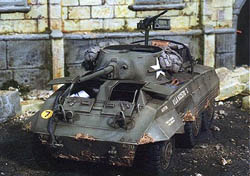 The Kit
The Kit
The kit consists of 210 parts in the usual olive drab plastic plus a length of twine for the tow cable. The quality of the parts is everything we have come to expect from Tamiya, crisp with detail everywhere. On the upper hull section, the turret ring and drivers compartment is a separate piece, making it easy to produce an M20. This could be by either Tamiya at a later stage or a conversion by an aftermarket company or even by the modeller. Also separate are the engine compartment hatches, although no engine is included. The wheels have brake drums as separate pieces which trap the usual poly cap for attaching the wheels to the axles.
There are a number of small ejection pin marks on some pieces, the inside of the front hatches, turret walls and some interior parts. These have been deliberately engineered by Tamiya to be as small as possible compared to others not seen when the kit is finished. Being small they are easily removed with fine sanding (they are too small to waste filler on).
Construction
The kit is built basically straight from the box for the purposes of this review, to explain the construction and highlight any traps etc. I did add a few details such as drilling out the exhaust and gun barrels and thinning of the head light guards for a better appearance, plus other details as explained below.
Steps 1 to 4 is the lower hull section and suspension. The center on the lower hull is a separate piece to allow for good detail on both sides. The drive train is in one-piece (becoming a Tamiya trademark) allowing precise alignment. Added to this piece are the insides of the diffs, steering arms, springs and shock absorbers. No problems were encountered and by following the instructions you shouldn't have problems either. I did leave the exhaust off to be painted separately.
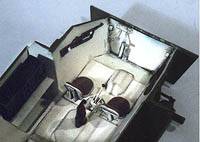 Steps 5 to 6 is the lower hull interior. This consists of rear and side bulkheads, front seats and gear shift lever. Also is an excellent driver's instrument panel with raised detail, which comes up a treat with careful painting. Note the two front seat backrests are different shapes, take care to get them the right way around. Also included is the central fire extinguisher and radio in left side sponson, both are well detailed. I again left these separate for painting.
Steps 5 to 6 is the lower hull interior. This consists of rear and side bulkheads, front seats and gear shift lever. Also is an excellent driver's instrument panel with raised detail, which comes up a treat with careful painting. Note the two front seat backrests are different shapes, take care to get them the right way around. Also included is the central fire extinguisher and radio in left side sponson, both are well detailed. I again left these separate for painting.
A few details were added to the interior. I added the driver's accelerator, brake and clutch pedals from thin card and wire and the hand brake lever from stretched sprue. I also added two M1 carbines in racks on the front sidewalls as these can be seen throught the large hull hatches. I then masked off the edges and sprayed the interior Matt white, followed by detail painting and weathering. Note the inside of the upper hull around the two front hatches is coloured olive drab and not white.
Step 7 Attach the upper and lower hull sections along with the engine bay doors and the insert with the turret ring and driver's hatches. Before attaching, you must open up the locating holes for the tool storage. There are optional holes, obviously for the different tool storage on an M20. The holes needing opening are indicated by small arrows on the inside of the hull top, be sure to open only these and not all holes. Fit of the hull sections was spot on, no filler required at all.
Step 8 Assembly of the wheels is straightforward with the separate brake drums trapping the poly cap to the main wheel section. I removed the small raised mould line around the center of the tread pattern with 'wet and dry paper', light sanding of the edges of the tread pattern also removes the 'sharp' edge and gives a more realistic appearance to the tyres.
In Steps 9 to 11 you attach all the small items to the hull. These include the headlights 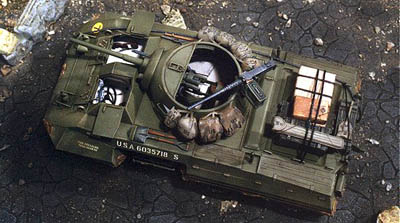 with guards (thinned down for a more realistic appearance), lifting lugs, rear engine deck handles and other small items. There are a couple of choices here with either mine racks or storage boxes on the hull sides. As most photos I have seen of WWII vehicles have the mine racks, I fitted these. If you are going to fit the wheel guards, you have to attach the wheels at this stage as they can't be attached after the guards are fitted. You also have the choice of open or closed front hatches, I left these off until all painting was finished. No problems were encountered with the fit of any of these parts, the only caution is to handle them with care as some are very small and finely moulded, just check out the rear towing pintle as an example.
with guards (thinned down for a more realistic appearance), lifting lugs, rear engine deck handles and other small items. There are a couple of choices here with either mine racks or storage boxes on the hull sides. As most photos I have seen of WWII vehicles have the mine racks, I fitted these. If you are going to fit the wheel guards, you have to attach the wheels at this stage as they can't be attached after the guards are fitted. You also have the choice of open or closed front hatches, I left these off until all painting was finished. No problems were encountered with the fit of any of these parts, the only caution is to handle them with care as some are very small and finely moulded, just check out the rear towing pintle as an example.
We now turn to the turret in Steps 12 to 15. The turret is in two halves with nicely moulded ammo racks attached to the inside walls. As mentioned earlier, there are a few small ejector pin marks on the sidewalls, these are easily removed with a piece of 'wet and dry'. The gun and mount are brilliant. The main gun breech is in two halves with separate breech block and barrel which is moulded in one piece eliminating any seam line (no oval barrel syndrome here). A well detailed guard frame is added to this. This assembly then fits between the two part gun mount which includes a separate elevation mechanism, added to this is the main telescopic sight and co-ax .30cal machine gun (this too is very well detailed). This all builds into a beautiful little assembly which is slipped through the opening in the turret front to which the outer mantlet is attached. This to is nicely done with subtle surface detail including cast numbers.
The turret ring and basket is moulded in one piece, which is a brilliant piece of engineering in itself, with excellent detail including rotation teeth. Attached to this are the crew seats, traverse mechanism and mounting brackets. This assembly then fits to the bottom of the turret. All this section is painted olive drab with various bits detail painted, e.g., the seat covers, sight and M/G.
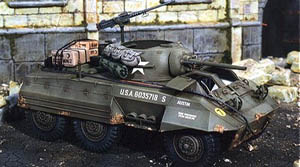 You have a choice of attaching the M36 gun mount to the turret top, this again is a nicely detailed assembly made up of 7 pieces. It is up to you if this is attached or not as both variations were widely seen during WWII. If using the gun ring make sure you don't open the locating hole in part D24 and attach part D37 to the turret rear instead of parts D36 & D40 (Parts D17, D36 & D40 are attached for the rear turret mounted .50cal M/G when not using the gun ring). The turret base has the mounting bases for two M1 carbines, but they aren't included in the kit. I found two spare M1s and attached these to the base with the top clips made from thin paper. These added a more 'lived in' appearance to the turret. The M2 M/G had the barrel handgrip added from an etched detail set.
You have a choice of attaching the M36 gun mount to the turret top, this again is a nicely detailed assembly made up of 7 pieces. It is up to you if this is attached or not as both variations were widely seen during WWII. If using the gun ring make sure you don't open the locating hole in part D24 and attach part D37 to the turret rear instead of parts D36 & D40 (Parts D17, D36 & D40 are attached for the rear turret mounted .50cal M/G when not using the gun ring). The turret base has the mounting bases for two M1 carbines, but they aren't included in the kit. I found two spare M1s and attached these to the base with the top clips made from thin paper. These added a more 'lived in' appearance to the turret. The M2 M/G had the barrel handgrip added from an etched detail set.
Again no problems were encountered during this sequence, this is helped by the precise and well detailed instructions, something we have come to expect from Tamiya.
Step 16 is the final assembly, attaching the turret to hull and assembly of the nicely detail figure. There is only one figure with the kit, that of a standing GI looking through field glasses. No crew figures are included but I'm sure the resin figure companies will come the rescue here. Warriors, with their excellent M18 crew spring to mind; these figures could easily be used for the M8 as well.
Painting and Finishing
The hull and turret were painted separately. Firstly the interiors were masked off and an overall coat of Humbrol Super Enamel Olive Drab (No.155) was airbrushed. This was followed when dry with a coat of Xtra Color Gloss for the decals. Four marking options are provided, all WWII (this is a little surprising given the M8's extended service in Korea, Vietnam and elsewhere). They are (1) 4th Armored Division, 25th Cavalry Reconnaissance Mechanized A Troop, Spring 1945. (2) 2nd Armored Division 82nd Armored Reconnaissance Battalion C Company 3rd Platoon. (3) 7th Armored Division, 87th Cavalry Reconnaissance Squadron Mechanized A Troop, Aug 1944 France. (4) Free French Army, 5th Armored Division, 1st REC Squadron, 2nd Platoon, France 1944.
The decals are nicely printed if not a little thick as per Tamiya decals. But they adhere well with the use of a decal setting solution. A nice touch is the decal for the engine deck star and circle that is in three pieces to fit over the raised intake louvers.
I chose option (3) as there is a photo of this vehicle on page 10 of Squadron Signal's 'D-Day to Berlin'. It also appears on the cover of the new Squadron Signal 'US Armored Cars in Action', but take note, the illustration is incorrect as it shows a .30cal M/G on the turret. This should be the usual .50cal as per the photo in 'D-Day to Berlin.'
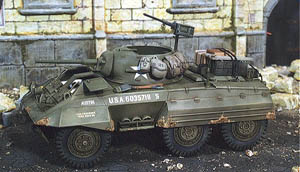 After decaling was complete, and the final coat of Matt varnish applied was dry, the model was given a wash with thinned Raw Umber oil paint to bring out the details and finally drybrushed with various earth colours to give the final weathered effect. The mud was a mixture of paint and plaster to give that chunky appearance when dry.
After decaling was complete, and the final coat of Matt varnish applied was dry, the model was given a wash with thinned Raw Umber oil paint to bring out the details and finally drybrushed with various earth colours to give the final weathered effect. The mud was a mixture of paint and plaster to give that chunky appearance when dry.
The storage on the rear deck and around the turret is from various Verlinden update sets. (Don't forget to add straps etc. to the storage to give a realistic appearance. It's amazing how many models you see with gear stuck to turrets with no visible means of support.)
Conclusion
As you may have gathered, I am extremely impressed with this kit. It is up to the standards we have come to expect from Tamiya. As with their other recent releases, I didn't have to bother with any filler. While the interior detail is good, there is obviously scope for additional detail to be added for those wanting to 'give it the works'.
It is a welcome addition to the range of allied vehicles now available in kit form and as mentioned this kit is set up to easily produce an M20 variant some time in the future.
I would highly recommend this kit to any anyone. While its ease of assembly is good, younger modellers' may be challenged by some of the smaller parts, but with assistance from the 'old man' everyone should enjoy building it. I myself will be building more as the variations and markings are almost endless.
The Base
The ruined church is from Verlinden as are the stained glass. Various bits of rubble were spread around. This is not the M8's permanent home as I plan to incorporate it into a diorama with Tamiya's forthcoming M26 Dragon Wagon (Yes, it's defiantly on the way around Christmas).
References
US Armored Cars in Action: Squadron Signal Publications
D-Day to Berlin: Squadron Signal Publications
Armor in Korea: Squadron Signal Publications
Armor in Vietnam: Squadron Signal Publications
Panzer Magazine: March '89
Ground Power Magazine: No.035 4/97
Heavy Metal: Arms & Armour Press
AFV Interiors: Web site
© Copyright 2023 by Internet Modeler
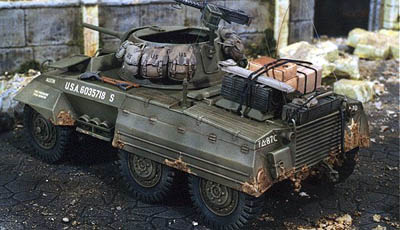
 The Kit
The Kit Steps 5 to 6 is the lower hull interior. This consists of rear and side bulkheads, front seats and gear shift lever. Also is an excellent driver's instrument panel with raised detail, which comes up a treat with careful painting. Note the two front seat backrests are different shapes, take care to get them the right way around. Also included is the central fire extinguisher and radio in left side sponson, both are well detailed. I again left these separate for painting.
Steps 5 to 6 is the lower hull interior. This consists of rear and side bulkheads, front seats and gear shift lever. Also is an excellent driver's instrument panel with raised detail, which comes up a treat with careful painting. Note the two front seat backrests are different shapes, take care to get them the right way around. Also included is the central fire extinguisher and radio in left side sponson, both are well detailed. I again left these separate for painting. with guards (thinned down for a more realistic appearance), lifting lugs, rear engine deck handles and other small items. There are a couple of choices here with either mine racks or storage boxes on the hull sides. As most photos I have seen of WWII vehicles have the mine racks, I fitted these. If you are going to fit the wheel guards, you have to attach the wheels at this stage as they can't be attached after the guards are fitted. You also have the choice of open or closed front hatches, I left these off until all painting was finished. No problems were encountered with the fit of any of these parts, the only caution is to handle them with care as some are very small and finely moulded, just check out the rear towing pintle as an example.
with guards (thinned down for a more realistic appearance), lifting lugs, rear engine deck handles and other small items. There are a couple of choices here with either mine racks or storage boxes on the hull sides. As most photos I have seen of WWII vehicles have the mine racks, I fitted these. If you are going to fit the wheel guards, you have to attach the wheels at this stage as they can't be attached after the guards are fitted. You also have the choice of open or closed front hatches, I left these off until all painting was finished. No problems were encountered with the fit of any of these parts, the only caution is to handle them with care as some are very small and finely moulded, just check out the rear towing pintle as an example. You have a choice of attaching the M36 gun mount to the turret top, this again is a nicely detailed assembly made up of 7 pieces. It is up to you if this is attached or not as both variations were widely seen during WWII. If using the gun ring make sure you don't open the locating hole in part D24 and attach part D37 to the turret rear instead of parts D36 & D40 (Parts D17, D36 & D40 are attached for the rear turret mounted .50cal M/G when not using the gun ring). The turret base has the mounting bases for two M1 carbines, but they aren't included in the kit. I found two spare M1s and attached these to the base with the top clips made from thin paper. These added a more 'lived in' appearance to the turret. The M2 M/G had the barrel handgrip added from an etched detail set.
You have a choice of attaching the M36 gun mount to the turret top, this again is a nicely detailed assembly made up of 7 pieces. It is up to you if this is attached or not as both variations were widely seen during WWII. If using the gun ring make sure you don't open the locating hole in part D24 and attach part D37 to the turret rear instead of parts D36 & D40 (Parts D17, D36 & D40 are attached for the rear turret mounted .50cal M/G when not using the gun ring). The turret base has the mounting bases for two M1 carbines, but they aren't included in the kit. I found two spare M1s and attached these to the base with the top clips made from thin paper. These added a more 'lived in' appearance to the turret. The M2 M/G had the barrel handgrip added from an etched detail set. After decaling was complete, and the final coat of Matt varnish applied was dry, the model was given a wash with thinned Raw Umber oil paint to bring out the details and finally drybrushed with various earth colours to give the final weathered effect. The mud was a mixture of paint and plaster to give that chunky appearance when dry.
After decaling was complete, and the final coat of Matt varnish applied was dry, the model was given a wash with thinned Raw Umber oil paint to bring out the details and finally drybrushed with various earth colours to give the final weathered effect. The mud was a mixture of paint and plaster to give that chunky appearance when dry.